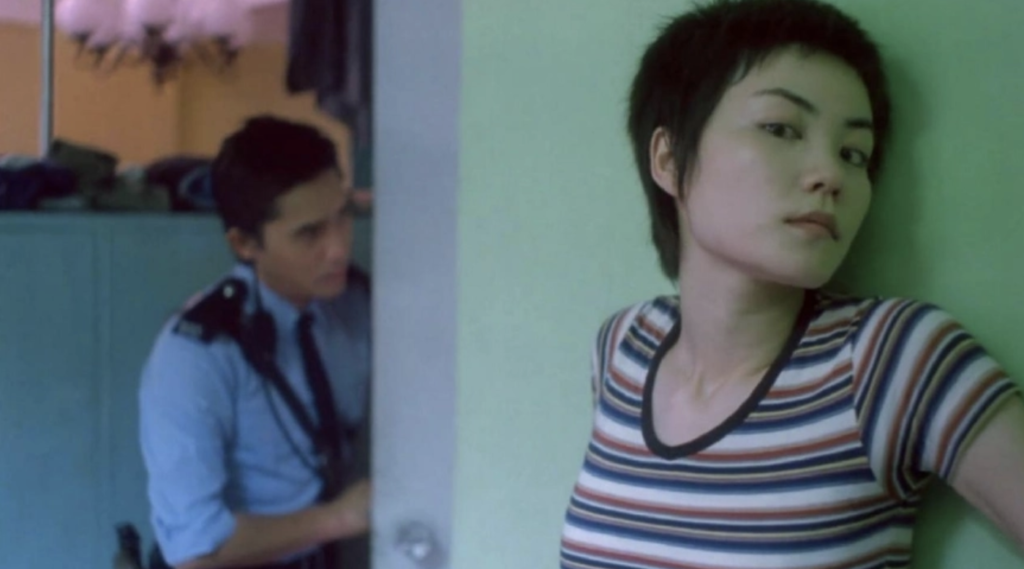In this review, I want to focus on the aesthetic designs rather than philosophical lessons as I really appreciate the director Wang JiaWei’s art style. The movie is composed of two parallel stories, regarding two protagonists’ break-up stories, with emotions enhanced by masterful camera language.
The first story began in a scene that introduces the assassin Lin Qingxia in her strange outfit, moving through narrow, crowded alleys with swaying camera shots. The cautious looks of the Indian characters and the eerie music create a tense and uneasy atmosphere. The next scene shows a deep blue sky with a strong urban vibe. The static shot contrasts with the earlier shaky ones, giving a feeling of emotional coldness in the city. This is followed by a monologue-style introduction from the police officer Takeshi Kaneshiro. Shaky chase shots then lead to a brief moment where Lin Qingxia and Takeshi Kaneshiro pass each other. The focus then shifts to a medium-long shot of Takeshi Kaneshiro making a phone call outside a fast-food restaurant. His monologue during the call shows his pain and struggle after a breakup. At the same time, the story cuts to Lin Qingxia working with a group of Indians to prepare for a drug smuggling operation, shown in scenes full of chaos, clutter, and dirt. The quick cuts, shaky camera movements, visual effects, and fast-paced Indian-style music heighten the tension and unease. The scenes continue to switch between the two characters. One side shows the stressful smuggling operation with fast-moving shots, while the other focuses on Takeshi Kaneshiro’s quieter moments, including his monologues, long shots, and close-ups. As the story develops through these changes, Lin Qingxia’s crime plan ultimately fails, and Takeshi Kaneshiro never reconciles with his girlfriend. Later, Takeshi Kaneshiro is shown in a convenience store, expressing his emotions through a series of scenes involving cans. His long monologues and his attachment to these items reflect his sadness in a unique way. A scene at the fast-food restaurant, where he makes a phone call, uses a mix of long shots, changes in focus, and tilted angles to show his growing hopelessness. At home, close-ups of him eating canned food, captured with cold blue lighting and fixed camera angles, emphasize his loneliness. Meanwhile, Lin Qingxia, tired after a fight and chase with her enemies, hides in a bar. There, the two main characters finally meet. In the bar, these two lonely and broken people talk. Close-up tracking shots of their conversation show their shared exhaustion and the emotional distance between them. The fragmented reflections of their faces in the bar’s mirror highlight this sense of separation. After their brief meeting, they each go their own way, leaving behind only a simple “happy birthday” and a pair of clean high heels.

The second story began as the song “California Dreamin’ plays, fast-food worker Faye Wong is introduced in a freeze-frame shot, while the other protagonist, police officer Tony Leung, appears through a fixed-focus shot that gradually zooms in on his face as he stands before her. A long take captures Faye Wong dancing to the music in the fast-food restaurant, quickly portraying her as a quirky and lively girl. Meanwhile, the director uses Tony Leung’s conversation with the restaurant owner to shape him as a slow-to-react, somewhat oblivious man. During their dialogue, Faye Wong’s blurred or fleeting figure occasionally appears in the background, suggesting her growing awareness and attention to their conversation. As a plane takes off on the runway, symbolizing the beginning of a relationship between Tony Leung and the flight attendant, the scene transitions to Tony’s memories. Moments of sweetness with his ex-girlfriend, accompanied by soft jazz, create a relaxed and happy mood, with a model aeroplane flying slowly in Tony’s hands serving as a key visual cue. However, when the memory fades and reality sets in, the camera returns to the fast-food restaurant, where Tony is having a resigned conversation with the owner.
Later, Tony’s ex-girlfriend delivers a breakup letter to the restaurant, marking a shift in the story. Faye Wong is now seen wearing a T-shirt with a heart design on the chest, hinting at her changing emotions. In contrast, Tony remains at home, talking to his household items. Fixed close-up shots in cold tones highlight his sadness and loneliness. This emotional disconnect between the two characters reflects the distance between their hearts. Subsequent scenes follow both characters at the market, with shaky handheld camera shots and their casual conversations creating a sweet and down-to-earth atmosphere. The film then focuses on Faye Wong’s playful “destruction” of Tony Leung’s apartment. These scenes emphasize her mischievous, childlike charm and deep feelings for Tony. Quick cuts combined with cheerful, airy music enhance the lively and whimsical tone of her actions. Despite the significant changes Faye makes to his home, Tony’s obliviousness—whether due to his attachment to his ex or his natural slowness—prevents him from noticing these alterations. When he finally catches Faye in the act, his reaction is surprisingly calm and indifferent, underscoring his slow nature. The camera then shifts back to Tony Leung’s darkly humorous monologues with his household items. These reflective moments eventually help him move on from his heartbreak. When the slow-to-react Tony finally decides to ask Faye out to meet him at a local California-themed bar, Faye has already left for a different “California,” leaving behind only a hand-drawn plane ticket.

